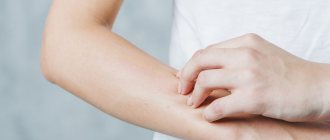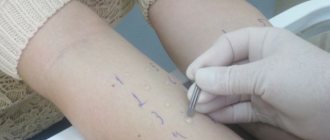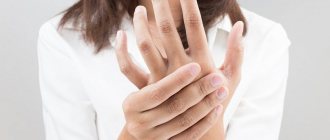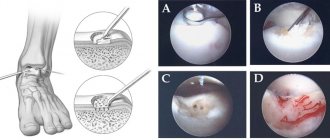Last update: 02/21/2021
Allergic reactions often cause various skin manifestations - rash, redness, irritation or swelling. Allergic dermatitis can often be difficult to distinguish from other skin conditions, such as infections or hives. Allergies are especially often confused with prickly heat, which occurs due to poor hygiene or temperature conditions.
What is the difference between prickly heat and allergies and how to determine which disease a child or an adult is suffering from? In order to answer this question, it is necessary to know the causes and symptoms of each disease and the characteristics of their course. In addition, the photos of heat rash and allergies presented on this page will help you.
What is prickly heat and why does it occur?
This is exactly the case when the name of the disease speaks for itself. Miliaria occurs when a person sweats frequently. At the same time, the excretory ducts of the sweat glands become blocked and a rash appears. Most often, the disease manifests itself in closed areas of the body - on the back, neck, legs, buttocks, armpits, and also in skin folds. If parents put a hat on their baby that is out of season, heat rash can appear on the head and even on the face, especially in those places where hair falls on the skin.
| Our expert Polina Vasilyeva dermatologist |
| Most often, heat rash can be noticed in those places on the body where it is damp and warm, primarily under the diaper. Heat rash also affects areas of the skin that have difficult access to air - the neck, upper chest, back, crooks of the arms and legs, armpits, lower back, behind the ears and in various skin folds. |
Miliaria occurs not only in children, but in adults too, but much less frequently. The reasons are quite obvious. Firstly, the baby's skin is softer and thinner. Secondly, the thermoregulation of a child under one year old is very far from ideal - he easily becomes hypothermic and even more easily overheats. Finally, an adult is able to understand that he is hot and take off excess clothes, but a newborn is completely dependent on the will of his parents. That is why the likelihood of heat rash in a one-month-old baby is much higher.
| Our expert |
Clinical researches
Clinical studies have proven the effectiveness, safety and tolerability of the products. The products are suitable for daily care of children's skin with mild to moderate forms of atopic dermatitis and during remission, accompanied by a decrease in the quality of life of patients.
Sources:
- Sukolin Gennady Ivanovich, Clinical dermatology. A short guide to the diagnosis and treatment of dermatoses, publishing house: Notabene, 2017
- Pankratov Valentin Gavrilovich, Pankratov Oleg Valentinovich, Infectious dermatology in the practice of primary care physicians, New Knowledge Publishing House, 2015
- Mancini A. J., Krouchuk D. P., Pediatric dermatology. Publisher: Practical Medicine, Directory, 2018
- Kildiyarova Rita Rafgatovna, Pediatrician for every day. Guide for doctors, publishing house GEOTAR-Media, 2021
Photos of heat rash
Photo album on the diseasePolina Vasilyeva
dermatologist
| This disease most often occurs in young children, since their thermoregulation nerve centers are still imperfect and almost do not function. Sweating develops during the first two years of a child's life. Due to functional immaturity and a number of other factors, the sweat glands become blocked and a rash forms on the skin - miliaria. Factors influencing its appearance include, for example, incorrectly selected diapers, excessive wrapping of young children, lack or insufficiency of air baths, and much more. |
Treatment
Miliaria can occur at any time of the year, but most often it manifests itself during the hot period, when we sweat a lot. It can also appear on vacation in warm countries. It is necessary to treat prickly heat, and as soon as possible. You can get rid of a mild form in one to two weeks. In severe cases, the sweat glands become depleted over time, leading to dry skin. Against the background of deep heat, infection and microbial eczema may occur. But it is much more difficult to deal with it - treatment can take years. This is another reason why you should get tested without delay. In newborns, during the treatment of prickly heat, you should discard the cream, replacing it with powder, which will absorb excess moisture and allow the skin to breathe. You can add chamomile decoction to bathing water, which soothes the skin and helps restore it. And don’t forget about the need for daily air baths. Sometimes it is recommended to treat the skin with zinc oxide powder or salicylic-zinc ointment, but such treatment must be prescribed by a doctor. Treatment of prickly heat in adults begins with eliminating the factors that caused it. Of course, nothing can be done about the hot weather, but if you are one of the people with excessive sweating, you can still make your life easier. Choose loose, non-restrictive clothing made from natural materials, and if necessary, use cosmetic talc in areas where clothing or underwear may rub the skin. On hot days, you should not use cosmetics that can clog pores or greasy creams. It is better to limit yourself to water-based lotion. Skin affected by prickly heat must be wiped with an antiseptic - for this, alcohol solutions of salicylic or boric acid, or a weak aqueous solution of potassium permanganate are used. To reduce itching and swelling, antihistamines are prescribed - tavegil or suprastin.
What does prickly heat look like in children?
At first, the symptoms look quite harmless - just a little redness. It is very important not to cause heat rash in a child: in the initial stages of development it is easy to get rid of, but later treatment may be required. The disease goes through the following stages:
- If parents do not think about how to remove heat rash from their child, or fight it incorrectly, the disease can move from the surface of the epidermis into the deeper layers of the skin. The inflammatory process begins and redness appears around the blisters.
- In advanced cases, bacteria penetrate the bubbles, causing their contents to become cloudy, and this looks very unpleasant not only in life, but even in the photo. The amount of rash increases, the skin begins to get wet. The disease develops especially quickly if the newborn is weakened.
- Mild redness of the skin, sometimes accompanied by itching. The baby may reach out to irritated areas, touch and scratch them.
- If the child continues to overheat, a rash appears in the red areas in the form of tiny blisters filled with clear liquid. They look almost like beads of sweat appearing, but only in a shell.
- If parents do not think about how to remove heat rash from their child, or fight it incorrectly, the disease can move from the surface of the epidermis into the deeper layers of the skin. The inflammatory process begins and redness appears around the blisters.
- In advanced cases, bacteria penetrate the bubbles, causing their contents to become cloudy, and this looks very unpleasant not only in life, but even in the photo. The amount of rash increases, the skin begins to get wet. The disease develops especially quickly if the newborn is weakened.
- Mild redness of the skin, sometimes accompanied by itching. The baby may reach out to irritated areas, touch and scratch them.
- If the child continues to overheat, a rash appears in the red areas in the form of tiny blisters filled with clear liquid. They look almost like beads of sweat appearing, but only in a shell.
Don't let heat rash develop and become a problem that requires treatment. When the first symptoms appear on the baby’s back, head, face or other places on the baby’s body, eliminate the cause of overheating. If this doesn't help, consult a doctor!
| Our expert |
Accurate diagnosis
The disease is diagnosed during an examination in a dermatologist's office. To exclude pyogenic and yeast infections, toxic erythema, additional examination is carried out.
It is difficult to distinguish heat lichen from urticaria. But the first is characterized by a rash in areas of increased sweating. When the skin is stretched, it disappears. Allergies are accompanied by accompanying symptoms:
- Purulent conjunctivitis.
- Drowsiness.
- Weakness.
- Dyspnea.
- Runny nose.
- Cough.
- Headache.
- Tearing.
If a violent reaction develops, the allergen is found and human contact with it is eliminated.
Polina Vasilyeva
dermatologist
| Miliaria does not require special treatment. It is necessary to change the care regimen and keep the baby's skin clean to avoid infection. |
In cases where prickly heat has developed from redness to a rash, and then bacterial infection occurs, treatment with special creams and ointments may be prescribed. If the symptoms show that the disease has reached a serious stage, consult a doctor and he will tell you how to treat it. Take regular photos of problem areas to track progress.
| Our expert |
When and which doctor to contact
The patient copes with the first stage of prickly heat on his own. If severe swelling, crusts and pustules appear, the help of a dermatologist is required. After communicating with the patient, studying his medical record, and external examination, the doctor determines the cause of the condition and suggests measures to eliminate it. You may need to donate blood for a general analysis or to determine hormone levels.
The underlying disease is treated simultaneously with the elimination of signs of prickly heat. Medicines are prescribed by a doctor. Folk remedies are also used after its approval. If you are obese, you may need the help of a nutritionist. If the disease is associated with ovarian dysfunction during menopause, consultation with a gynecologist is advisable. Self-medication often causes serious complications, defects on the skin of the face and other parts of the body.
Polina Vasilyeva
dermatologist
| Rashes can be treated with products containing zinc oxide (sudocrem), or diaper cream, powder. If you are concerned about itching, a cream with dexapanthenol (“Bepanten”, “Bepanten plus”, “Cicaplast”) or soothing creams that are sold in pharmacies will help. The products “Drapolen”, “Bepanten”, “Desitin” - their It is recommended to apply a thin layer and do not put on the diaper until completely absorbed. |
Disease prevention
Preventing miliaria is easier than treating it. To do this you will need to follow a number of rules:
- Refrain from swimming in open waters.
- Avoid fatty creams.
- To restore water balance, drink juice, compotes, and plant decoctions.
- Maintain a healthy microclimate in the premises.
- Take a contrast shower and use antibacterial soap to not only cleanse the skin, but also reduce sweating.
- Avoid physical activity in the heat.
- Watch your weight.
- Exercise moderation when sunbathing.
Wear clothing appropriate to the weather, size, and physical activity, made from breathable natural fabric. This will prevent the greenhouse effect. The same requirements apply to shoes.
How to prevent heat rash in a child?
Prevention of heat rash is very simple - you just need to make sure that the child is comfortable and does not sweat. Here is a list of rules you need to remember:
- Create the right climate in your baby's room. Maintain the temperature at 18–20 °C and don’t worry that the newborn will freeze - this will be just right for him.
- If your baby's crib is exposed to direct sunlight, move it to a different location.
- Ventilate the room regularly, do not allow the air to stagnate.
- Do not buy clothes for your baby made from synthetic fabrics that do not breathe. Choose natural.
- Bathe your baby daily.
- Do not wrap your child up - both at home and on walks.
- Change diapers at least every 3-4 hours. After you've removed the used diaper and dried your baby's skin, let her breathe for a few minutes.
Learn to recognize the symptoms of overheating. If the child becomes lethargic and his face turns red, it means he is very hot. During a walk, especially in the cold season, these signs are easy to miss: the baby’s face, as the only open part of the body, rather reflects the weather outside than the general condition of the body. Gently slide your hand under your baby's clothes and check the back of the neck. If the baby's skin is dry and warm, everything is fine, but if it is wet, the baby is overheated, and this may result in the appearance of heat rash.
How to distinguish heat rash from allergies in a child?
An allergy is a pathological reaction of the immune system, and it is usually not exchanged for such trifles as local redness on the face or back. Allergy symptoms manifest themselves in a complex manner, often accompanied by nasal congestion and runny nose, shortness of breath, and redness of the eyes. If at the same time a rash is discovered on the baby’s body, the raging immune system usually “draws” mirror pictures. For example, skin problems occur on both elbows at once, rashes appear on the stomach or groin, symmetrical relative to the center line of the body.
The allergy usually comes out in the form of eczema (distinguished by the formation of tiny blisters that burst very quickly and leave weeping wells) or urticaria (almost unmistakably recognized by raised, flat blisters). These symptoms are completely different from prickly heat. If in doubt, look on the Internet for photos of these skin diseases. Better yet, take a photo of the problem skin area yourself and send it to the doctor.
Due to inexperience, other skin diseases can be mistaken for heat rash in a child, but they also have their own distinctive characteristics.
- Miliaria and contact dermatitis
Contact dermatitis is a direct response of the skin to an irritant and, true to its name, is always limited to areas of contact. For example, if the problem is in the composition of new socks, redness will appear on the legs, right under them, and if in the new shampoo, on the head.Dermatitis occurs quite easily and spontaneously in dry places - where prickly heat has nothing to do. And he’s in no hurry to leave—days, sometimes weeks, pass before the symptoms of this disease disappear.
- Heat rash and diaper rash
Diaper rash also likes warm and humid places, but has a different cause. They occur as a result of the development of a bacterial infection in irritated or chafed areas of the skin on the neck, groin, armpits and other places. Diaper rash is more painful for newborns and children under one year old, because they have many secret folds on the body.At the first stage of development, diaper rash shows the same symptoms as prickly heat - redness on the skin. Later, cracks appear in these places, then ulcers. The fact that it is almost impossible to distinguish these two diseases in the early stages should not upset you. Start treatment on two fronts at once - diaper rash cream plus control and prevention of overheating from prickly heat. One will help, and the other definitely won't hurt.
Causes
Miliaria mainly affects areas of the skin with insufficient ventilation:
- areas of natural folds of the body (armpits, groin area, knee and elbow bends),
- the area under the mammary glands in women and very obese men,
- the area behind the ears in children and adults with thick hair,
- the area between the thighs, if the legs are very full,
- the area that is constantly under clothing (the area under a bra, swimming trunks, diapers), bandages, bandages.
Contributors to the development of prickly heat: synthetic clothing, thick non-breathable fabrics, feverish conditions, elevated air temperatures combined with high humidity, trauma and chafing of the skin, the use of creams, oils, fatty cosmetics that clog pores, diabetes mellitus, metabolic diseases, excess weight. Causes of excessive sweating may include disruptions in the body's endocrine system, insufficient functioning of the heart, blood vessels, kidneys and disorders of the nervous system. Sometimes an increase in sweating (hyperhidrosis) is influenced by a genetic factor, i.e. heredity and place of residence. In hot countries, acclimatization is always accompanied by increased sweating, and local residents have a tendency to hyperhidrosis.
Phytotherapy
The basis of herbal medicine are herbs and other plants that have an antiseptic, disinfectant and drying effect. Doctors recommend taking baths with the addition of infusions of chamomile, string, celandine or St. John's wort. To prepare them, just take 2-4 tablespoons of the raw material and pour a liter of boiling water, then leave until it cools completely.
Oak bark has a special effect on skin restoration, the many beneficial properties of which we have already described in one of the previous articles. It is effective not only as a remedy for sweating, but also as a natural remedy for treating prickly heat and restoring the skin to its former appearance. The tannins contained in its composition disinfect, restore, dry and tighten the skin, making it more elastic and attractive.
Who is susceptible
It is traditionally believed that prickly heat is the province of infants. “In fact, this skin reaction can occur in anyone: from newborns to the elderly. It also doesn’t matter whether a person has a pathology or is completely healthy, there are only nuances. If concomitant diseases are present, they can somewhat aggravate the disease, for example, due to the addition of a secondary infection,” notes immunologist Shulyaeva.
Also, against the background of concomitant diseases, notes Anna Shulyaeva, there may be reactive skin reactions. For example, if there is a history of allergic pathologies, prickly heat can be complicated by the activation of an allergic reaction - various swelling of the skin, redness of different areas of the skin.
Sage and cucumber will help get rid of acne Read more









